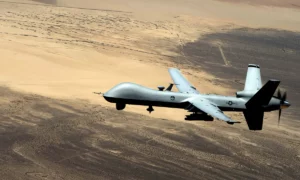Innovation and the DoD
Drone Technology

Innovation and the DoD …… for decades, satellites that took detailed pictures of Earth were only available to governments and the high-resolution images were classified. Today, commercial companies have their own satellites providing unclassified imagery. The government buys and distributes commercial images from startups to supplement their own and shares them with Ukraine as part of a broader intelligence-sharing arrangement that the head of Defense Intelligence Agency described as “revolutionary.” By the end of the decade, there will be 1000 commercial satellites for every U.S. government satellite in orbit.
International Scope
At the onset of the war in Ukraine, Russia launched a cyber-attack on Viasat’s KA-SAT satellite, which supplies Internet across Europe, including to Ukraine. In response, to a (tweeted) request from Ukraine’s vice prime minister, Elon Musk’s Starlink satellite company shipped thousands of their satellite dishes and got Ukraine back on the Internet. Other startups are providing portable cell towers – “backpackable” and fixed. When these connect via satellite link, they can provide phone service and WIFI capability. Another startup is providing a resilient, mesh local area network for secure tactical communications supporting ground units.
Nationalized Technology
Drone technology was initially only available to national governments and militaries but is now democratized to low price points and available as internet purchases. In Ukraine, drones from startups are being used as automated delivery vehicles for resupply, and for tactical reconnaissance to discover where threats are. When combined with commercial satellite imagery, this enables pinpoint accuracy to deliver maximum kinetic impact in stopping opposing forces.
Equipment from large military contractors and other countries is also part of the effort. However, the equipment listed above is available commercially off-the-shelf. Additionally, these are at dramatically cheaper prices than what’s offered by the large existing defense contractors, and developed and delivered in a fraction of the time. The Ukraine conflict is demonstrating the changing character of war such that low-cost emerging commercial technology is extremely effective when deployed against a larger 20th-century industrialized force that Russia is fielding.
Innovation and the DoD: Emerging Technology and the Entrepreneurial Ecosystem
Celebrate the organizations that have created and fielded these systems, the battle for the Ukraine illustrates much larger issues in the Department of Defense.
For the first time ever our national security is inexorably intertwined with commercial technology (drones, AI, machine learning, autonomy, biotech, cyber, semiconductors, quantum, high-performance computing, commercial access to space, et al.) And as we’re seeing on the Ukrainian battlefield they are changing the balance of power.
The DoD’s traditional suppliers of defense tools, technologies, and weapons – the prime contractors and federal labs – are no longer the leaders in these next-generation technologies. These include drones, AI, machine learning, semiconductors, quantum, autonomy, biotech, cyber, quantum, high performance computing, et al. They know this and know that weapons that can be built at a fraction of the cost and upgraded via software will destroy their existing business models.
Venture capital and startups have spent 50 years institutionalizing the rapid delivery of disruptive innovation. In the U.S., private investors spent $300 billion last year to fund new ventures that can move with the speed and urgency that the DoD now requires. Meanwhile China has been engaged in a Civil/Military Fusion program since 2015 to harness these disruptive commercial technologies for its national security needs.